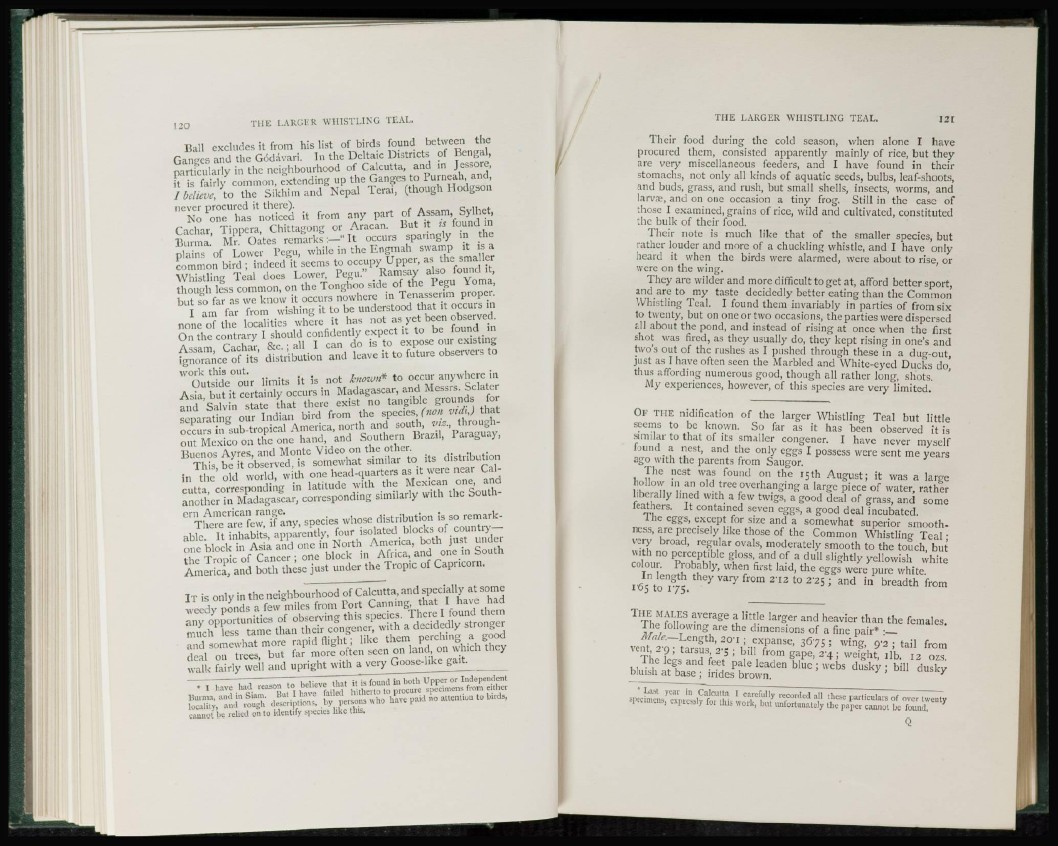
Ball excludes it from his list of birds found between the
Ganges and the Godavari. In the Deltaic Districts of Bengal,
particularly in the neighbourhood of Calcutta, and in Jessore,
it is fairly common, extending up the Ganges to Purneah, and,
/ believe; to the Sikhim and Nepal Terai, (though Hodgson
never procured it there).
No one has noticed it from any part of Assam, Sylhet,
Cachar, Tippera, Chittagong or Aracan. But it ¿5 found in
Burma. Mr. Oates remarks:—" It occurs sparingly in the
plains of Lower Pegu, while in the Engmah swamp it is a
common bird ; indeed it seems to occupy Upper, as the smaller
Whistling Teal docs Lower, Peou." Ramsay also found it,
though less common, on the Tonghoo side of the Pegu Yoma,
but so far as we know it occurs nowhere in Tenasserim proper.
I am far from wishing it to be understood that it occurs in
none of the localities where it has not as yet been observed.
On the contrary I should confidently expect it to be found in
Assam, Cachar, &c. ; all I can do is to expose our existing
ignorance of its distribution and leave it to future observers to
work this out.
Outside our limits it is not known* to occur anywhere in
Asia, but it certainly occurs in Madagascar, and Messrs. Sclater
and Salvin state that there exist no tangible grounds for
separating our Indian bird from the species, (non vidij that
occurs in sub-tropical America, north and south, vis., throughout
Mexico on the one hand, and Southern Brazil, Paraguay,
Buenos Ayres, and Monte Video on the other.
This, be it observed, is somewhat similar to its distribution
in the old world, with one head-quarters as it were near Calcutta,
corresponding in latitude with the Mexican one, and
another in Madagascar, corresponding similarly with the Southern
American range.
There are few, if any, species whose distribution is so remarkable.
It inhabits, apparently, four isolated blocks of country—
one block in Asia and one in North America, both just under
the Tropic of Cancer ; one block in Africa, and one in South
America, and both these just under the Tropic of Capricorn.
I T is only in the neighbourhood of Calcutta, and specially at some
weedy ponds a few miles from Port Canning, that I have had
any opportunities of observing this species. There I found them
much less tame than their congener, with a decidedly stronger
and somewhat more rapid flight; like them perching a good
deal on trees, but far more often seen on land, on which they
walk fairly well and upright with a very Goose-like gait.
* I have had reason to believe that it is found in both Upper or Independent
Burma, and in Siam. But I have failed hitherto to procure specimens from either
locality, and rough descriptions, by persons who have paid no attention to birds,
cannot be relied on to identify species like this.
Their food during the cold season, when alone I have
procured them, consisted apparently mainly of rice, but they
are very miscellaneous feeders, and I have found in their
stomachs, not only all kinds of aquatic seeds, bulbs, leaf-shoots,
and buds, grass, and rush, but small shells, insects, worms, and
larvae, and on one occasion a tiny frog. Still in the case of
those I examined, grains of rice, wild and cultivated, constituted
the bulk of their food.
Their note is much like that of the smaller species, but
rather louder and more of a chuckling whistle, and I have only
heard it when the birds were alarmed, were about to rise, or
were on the wing.
They are wilder and more difficult to get at, afford better sport,
and are to my taste decidedly better eating than the Common
Whistling Teal. I found them invariably in parties of from six
to twenty, but on one or two occasions, the parties were dispersed
all about the pond, and instead of rising at once when the first
shot was fired, as they usually do, they kept rising in one's and
two's out of the rushes as I pushed through these in a dug-out,
just as I have often seen the Marbled and White-eyed Ducks do,
thus affording numerous good, though all rather long, shots.
My experiences, however, of this species are very limited.
O F THE nidification of the larger Whistling Teal but little
seems to be known. So far as it has been observed it is
similar to that of its smaller congener. I have never myself
found a nest, and the only eggs I possess were sent me years
ago with the parents from Saugor.
The nest was found on the 15th August; it was a large
hollow in an old tree overhanging a large piece of water, rather
liberally lined with a few twigs, a good deal of grass, and some
feathers. It contained seven eggs, a good deal incubated.
The eggs, except for size and a somewhat superior smoothness,
are precisely like those of the Common Whistling Teal ;
very broad, regular ovals, moderately smooth to the touch, but
with no perceptible gloss, and of a dull slightly yellowish white
colour. Probably, when first laid, the eggs were pure white.
In length they vary from 212 to 2^25 ; and in breadth from
r65 to 175.
THE MALES average a little larger and heavier than the females.
The following are the dimensions of a fine pair* :—
Mole.—Length, 20'I ; expanse, 3675 ; wing, 9/2 ; tail from
vent, 2'9 ; tarsus, 2'S ; bill from gape, 2'4 ; weight, lib. 12 ozs.
The legs and feet pale leaden blue ; webs dusky ; bill dusky
bluish at base ; irides brown.
* Last year in Calcutta I carefully recorded all these particulars of over twenty
specimens, expressly for this work, but unfortunately the paper cannot be found.
Q